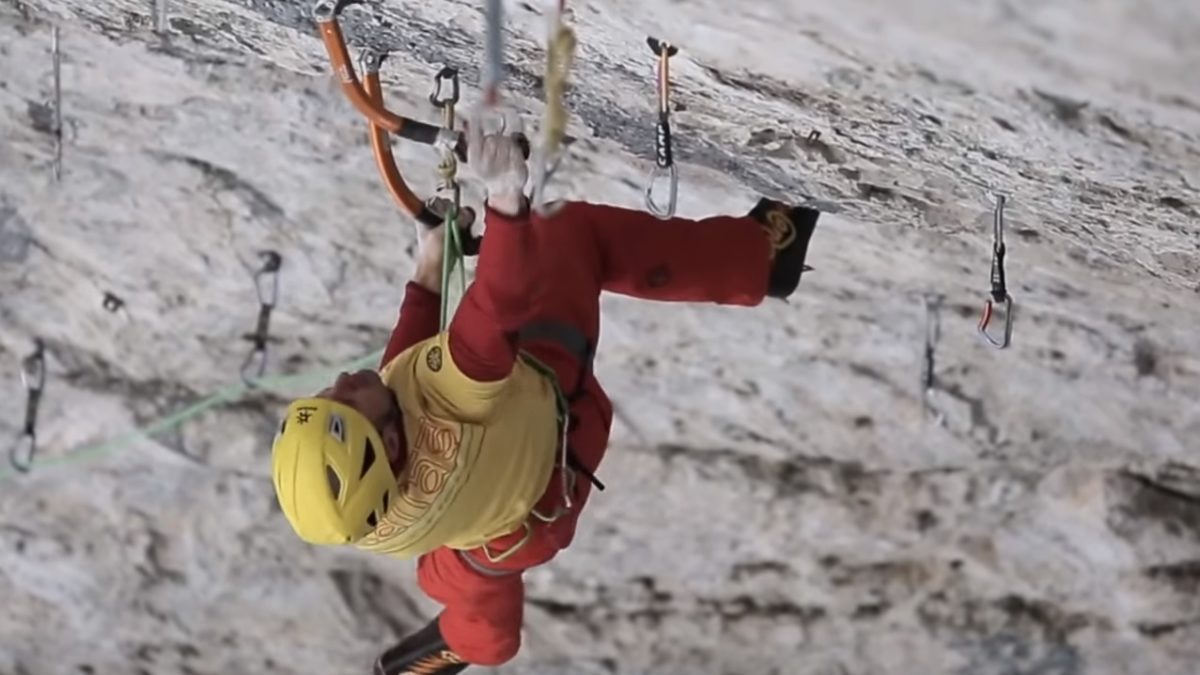It’s Drytooling Season in Canada – Five Tips to Climb Hard
Drytooling is a great way to improve grip strength to prepare for a winter of ice and mixed climbing

We’re coming into prime drytooling season across Canada. The sport is a great way to train during shoulder season when the rock is damp and cold, but there’s no ice yet.
Drytooling, if you don’t know, is when you climb rock using ice tools and crampons. It can get you into excellent shape for winter. Most, if not all drytool crags, are established on rock that wouldn’t be rock climbable. The rock is often chossy or seeps year-round, or both. Because of Canada’s extreme freeze/thaw cycles, we have a lot of cliffs that aren’t suitable for rock climbing but make excellent drytool crags.
Dytooling helps build endurance, tool-on-rock precision for mixed climbs, and can help you gain confidence standing on small rock edges in your boots with crampons. Learning how to place and trust your tools is an invaluable skill for when you’re attempting mixed, ice and alpine routes.
Where to Drytool in Canada
There aren’t a lot of open-to-all drytooling crags, and this list doesn’t include mixed crags where most lines are better with ice. Instead, these areas are best to visit during the shoulder season.
Comox Lake: A relatively new crag on Vancouver Island with a number of difficult lines.
Haffner Creek: While there’s a lot of ice and mixed lines (better in winter), a few fun drytool climbs can be found early season. See here for more.
Tool Shed: A short crag in Canmore with four good intro climbs. See here for more.
Playground: One of the most established drytool crags in Canada with over a dozen fun and steep lines. See here for more.
El Dorado: A drytool area with no, or few, manufactured holds, which means more real and difficult climbing. See here for more.
Drive-In: A fun close-to-the-road crag in Exshaw. Some pumpy lines. See here for more.
Fish Hatchery: A remote drytool crag north of Thunder Bay, Ont., that has access issues.
Drytool Tips
Be Strong: Drytooling takes a lot of power, both in your upper and lower body. As top mixed climber Gord McArthur says, “Your core, your upper body, lower back, legs, and shoulders; they all need to be on a solid foundation. Basically, head to toe needs to be firm.” These exercises will give you the foundation moving into sport specific strength training: pull-ups, squats, dead lifts, shoulder press, push-ups, dips and tricep extensions. After you build a solid foundation, then you can shift to more drytool-specific training. Spend a lot of time hanging from the tools, either off a hangboard, tree or beams in the garage. Match your hang time with core fitness, doing mid-body movements you can to build strength.
Tool Angle: In drytooling, the hold is what the pick is resting on, not the handle of your tool. So that means that the pull has to be constant and in line with the rock where your pick sits. You want to be sure that the shaft of your tool is 90 degrees to the horizontal axis of the hold. Holds aren’t always parallel to the ground, so you have to figure out its angle and react. Keep the tool on the hold by positioning your body to keep the pull in a constant direction. If your tool falls out of alignment, then you’ll fall off.
Open Hands: The best drytool climbers almost always have their thumbs open, unless they’re heading through a big roof. As top ice climber Will Gadd states, “With modern leash-less tools, you can almost always relax your hand to a “thumbs open” position after swinging or connecting with a hold (full-weight figure fours are an exception). Really… Most novices and even experienced climbers can hang on a lot longer when I get them to relax their hands and open their thumbs.”
Relax: Drytooling is scary because there’s a lot of potential to get hurt, even when you’re just clipping bolts at a crag. Staying focused and relaxed will help strip the fear away and remove the hesitation from your climbing. As Gadd says, “Trusting your tools involves relaxing, focusing on the required movement, and being O.K. with taking the spinning nasty falls that often result when a tool blows.” If you watch drytoolers at a crag, it’s easy to spot the over gripped ones versus the relaxed ones in the flow.
The Gear: Basically bring everything that you would for a day of cragging in the summer, except pack for colder and wetter conditions. Bring the stick-clip, belay glasses, quickdraws, a durable rope, helmet, tools, crampons, layers, belay puffy, thin gloves and belay gloves and a tarp.


